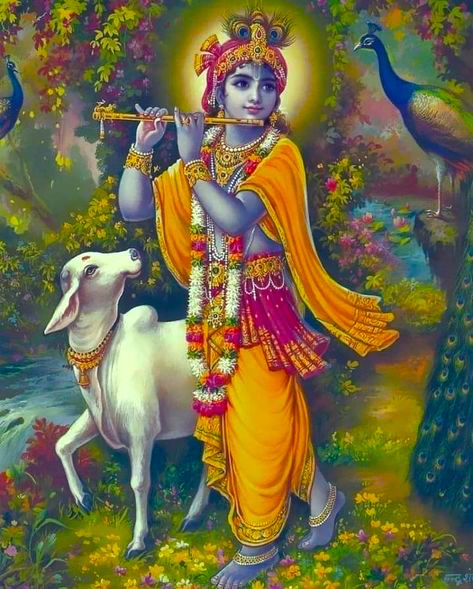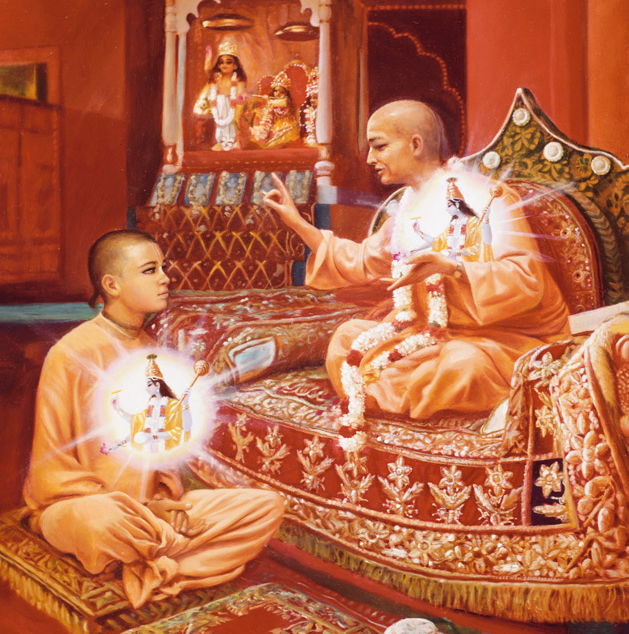Mahanidhi Swami
One day during the wave of a kalpa rising and falling in the endless ocean of time, Shankara Mahadeva visited Vraja Mandala and came to Govardhana Hill.
Astonished, amazed, overwhelmed and plunged into the ocean of Krishna prema, he gazed at Radha-kunda. Entering a deep state of prema samadhi, then and there Shivaji saw the beautiful divine forms of Radha and Krishna, realized Their sweet all-attractive qualities, and became tantalized with enchantment upon seeing Their nitya lilas, going on right before his prema-filled eyes.
Mahadeva clearly saw and realized the oneness of Radha-kunda—Shyama-kunda with sakshat Mahabhava Prema-svarupini Radha and Rasikashekara Srngara Rasaraja Sri Krishna. To glorify the power, mercy and sweet beauty of Sri Radha-kunda, Shivaji, trembling in divine bliss, spontaneously uttered a beautiful prayer which he called “the king of all prayers”.
Concluding his stotram, Shivaji gave a benediction (shruti-phala) combining his prayer and the endless mercy Sri Radha-kunda. Shivaji said, “Any sādhaka who recites this stava 100 times (Pandas say 108) while standing inside Sri Radha-kunda up to the thighs, navel, chest or neck will attain complete perfection in (dharma, artha, kāma, mokṣa) and ATTAIN KRISHNA PREMA!
“Everything that sadhaka says will come true and he/she will obtain Sri Radhika’s darshana, seeing Her even with his present eyes! Being supremely pleased with that sadhaka, Sri Radha will also grant darshana of Her dearly beloved Syamasundara.
“Then Vrajadhipa Syama, the Master of Vraja-dhama, will grant one entrance into His eternal pastimes (asta-kaliya-lila). Other than this, nothing more is ever hankered for by sincere devotees.” (Urdhvāmnāya-tantra v. 16-19) [Just see the kindness! Can there be any other lila-sthali in Vraja Mandala more merciful and beautiful than Sri Radha-kunda.]
This wonderful, divinely empowered stotram, the king of all prayers, forever plays in the minds and hearts of all the Radha-kunda Vrajavasis. It regularly dances upon their lips as they gaze upon Srimati Radharani, and heart fully express their love, gratitude and appreciation to Swamini for the blessing of their birth in Radha-kunda, the daily darshana of Her most compassionate and accessible divine form, and the most rarely attained golden opportunity of being able live in and serve Sri Radha Kunda.
All the brahmana children and others in Radha-kunda learn this prayer by the time they are five-years-old! And it is our constant prayer that birth after birth we will take birth in Sri Radha Kunda Dhama till that one merciful day when Lila Yugala grant me Their loving darshana and take me into Their eternal asta-kaliya-lilas…. ki jai!
For the pleasure of Radha Giridhari Shyama, Radha Ramana, Gopeshvara Mahadeva, Sri Advaita Prabhu, the Vrajavasis, Sri Gurudeva and all the devotees, we herein present Sri Shankara’s amazing prayer.
Śrī Rādhā-Kṛpā-Kaṭākṣa-Stava-Rāja
Spoken by Sri Shivaji to Sri Gaurī in Urdhvāmnāya-tantra
munīndra-vṛnda-vandite tri-loka-śoka-hāriṇī
prasanna-vaktra-paṅkaje nikuñja-bhū-vilāsini
vrajendra-bhānu-nandini vrajendra-sūnu-saṅgate
kadā kariṣyasīha māṁ kṛpā-kaṭākṣa-bhājanam? (1)
- Lord Siva said, Adored by all the best of sages, Radha removes all the miseries of the three worlds. Radha’s joyful face blooms like a lotus flower. In Vraja’s secret groves Radha delights in pastimes of love. Bhanunandini Radha is the charming daughter of King Vrsabhanu, and Radha always associates intimately with Sri Nandanandana. Radha, O when will You shower upon me Your sidelong glance of mercy?
aśoka-vṛkṣa-vallarī-vitāna-maṇḍapa-sthite
pravāla-vāla-pallava-prabhāruṇāṅghri-komale
varābhaya-sphurat-kare prabhūta-sampadālaye
kadā kariṣyasīha māṁ kṛpā-kaṭākṣa-bhājanam? (2)
- Radhika rests upon a flower throne beneath a canopy of creepers and boughs of Asoka. Kisori’s soft lotus feet radiate a pinkish glow like the rising sun or coral-colored freshly sprouted leaf buds. Rasesvari’s upraised hand bestows the benediction of fearlessness upon Her devotees. Radha is the abode of abundant opulences.
Radha, O when will You shower upon me Your sidelong glance of mercy?
anaṅga-raṅga-maṅgala-prasaṅga-bhaṅgura-bhruvāṁ
savibhramaṁ sasambhramaṁ dṛganta-bāṇa-pātanaiḥ
nirantaraṁ vaśī-kṛta-pratīti-nanda-nandane
kadā kariṣyasīha māṁ kṛpā-kaṭākṣa-bhājanam? (3)
- Radha’s eyebrow brows, curving like bows, suddenly unleash the invincible arrows of Her sidelong glances, which pierce Nandanandana with amorous delusion and bring Syama into reverential submission. In this way, Kṛṣṇa eternally comes under Radha’s complete control. This is further enhanced by Srimati’s crookedly-bending eyebrows that dance with the most auspicious sportive interest of the god of love! Radha, O when will You shower upon me Your sidelong glance of mercy?
taḍit-suvarṇa-campaka-pradīpta-gaura-vigrahe
mukha-prabhā-parāsta-koṭi-śāradendu-maṇḍale
vicitra-citra-sañcarac-cakora-śāva-locane
kadā kariṣyasīha māṁ kṛpā-kaṭākṣa-bhājanam? (4)
- Radhika’s form has a fair complexion brilliantly more effulgent than a combination of pure gold, lightning, and campaka flowers. The splendor of Candramukhi’s face defeats the glory of a million Autumn moons. Priyaji’s restless eyes, moving to and fro like young cakora birds, display astonishingly new and wonderful expressions at every moment. Radha, O when will You shower upon me Your sidelong glance of mercy?
madonmadāti-yauvane pramoda-māna-maṇḍite
priyānurāga-rañjite kalā-vilāsa-paṇḍite
ananya-dhanya-kuñja-rājya-kāma-keli-kovide
kadā kariṣyasīha māṁ kṛpā-kaṭākṣa-bhājanam? (5)
- Srimati Radhika is madly intoxicated with the beauty of Her own youth. Manini Radha is always adorned with Her pre-eminent ornament, that delightful sulking mood known as māna. Radha is colored by the delight of Her darling’s love for Her. Vilasini Radha is supremely expert in the art of loving affairs. In the incomparable realm of wonderful kuñjas, Kunjesvari is the most learned in all of love’s novelties. Radha, O when will You shower upon me Your sidelong glance of mercy?
aśeṣa-hāva-bhāva-dhīra-hīra-hāra-bhūṣite
prabhūta-śāta-kumbha-kumbha-kumbhi kumbha-sustani
praśasta-manda-hāsya-cūrṇa-pūrṇa-saukhya-sāgare
kadā kariṣyasīha māṁ kṛpā-kaṭākṣa-bhājanam? (6)
- Srimati Radhika is adorned with profound loving sentiments for Kṛṣṇa (e.g. anurāga, dhirādhira, kilakincita) that manifest as amorous gestures, ecstatic moods and gentle manners, which shine on Her person like a diamond necklace. Radha’s lovely breasts are plump like a pair of golden water pots or the cranial globes of a baby elephant. Radha resembles a swelling ocean of happiness full of (not water, but) the soft pollen of Her most glorious mild sweet smile. Radha, O when will You shower upon me Your sidelong glance of mercy?
mṛṇāla-vāla-vallarī taraṅga-raṅga-dor-late
latāgra-lāsya-lola-nīla-locanāvalokane
lalal-lulan-milan-manojña mugdha-mohanāśrite
kadā kariṣyasīha māṁ kṛpā-kaṭākṣa-bhājanam? (7)
- Radhika’s soft arms are like fresh, delicate lotus stems playfully swaying in the waves of a river. The restless roving glances of Radha’s deep blue eyes dance seductively like vine-tips in the breeze. Radha’s playful and alluring movements entice lovely meetings, and fascinate Mohana Himself to take refuge in Her charms. Radha, O when will You shower upon me Your sidelong glance of mercy?
suvarṇa-mālikāñcita-tri-rekha-kambu-kaṇṭhage
tri-sūtra-maṅgalī-guṇa-tri-ratna-dīpti-dīdhiti
salola-nīla-kuntala-prasūna-guccha-gumphite
kadā kariṣyasīha māṁ kṛpā-kaṭākṣa-bhājanam? (8)
- Srimati Radhika wears a pure golden necklace on Her neck which is as graceful as a lovely conch enhanced with three lines. Sobhangi is decorated with small jasmine garlands, and ornaments made with glistening jewels of three colors (diamond, emerald and pearl) that swing from Radha’s trisūtra (three auspicious cords tied around the neck of a new bride). Sundari Radha’s luxuriant black tresses, artfully woven with clusters of colorful flowers, sway to and fro. Radha, O when will You shower upon me Your sidelong glance of mercy?
nitamba-bimba-lambamāna-puṣpa-mekhalā-guṇe
praśasta-ratna-kiṅkiṇī-kalāpa-madhya-mañjule
karīndra-śuṇḍa-daṇḍikā-varoha-saubhagoruke
kadā kariṣyasīha māṁ kṛpā-kaṭākṣa-bhājanam? (9)
- Radha’s rounded hips are decorated by a belt of dangling flowers. Tiny tinkling jewel-bells hang from the flower belt on Radhika’s charmingly slender waist. Vrndavanesvari’s most beautiful thighs taper gracefully like the sloping trunk of the king of the elephants. Radha, O when will You shower upon me Your sidelong glance of mercy?
aneka-mantra-nāda-mañju-nūpurā-rava-skhalat
samāja-rāja-haṁsa-vaṁśa-nikvaṇāti-gaurave
vilola-hema-vallarī-viḍambi-cāru-caṅkrame
kadā kariṣyasīha māṁ kṛpā-kaṭākṣa-bhājanam? (10)
- Radharani’s captivating golden ankle bells, sweetly resounding with a host of Vedic mantras as She walks, resemble the warbling of a flock of royal swans. The elegant beauty of Gaurangi’s limbs as She walks along, mocks the grace of undulating golden creepers. Radha, O when will You shower upon me Your sidelong glance of mercy?
ananta-koṭi-viṣṇu-loka-namra-padmajārcite
himādrijā-pulomajā-viriñcajā-vara-prade
apāra-siddhi-ṛddhi-digdha-sat-padāṅgulī-nakhe
kadā kariṣyasīha māṁ kṛpā-kaṭākṣa-bhājanam? (11)
- Srimati Radhika is humbly bowed to by all the Lord Brahmas in the countless millions of universes created by Lord Visnu. Rasapriya Radha is worshiped by Śrī Lakṣmī, the goddess of unlimited millions of Vaikuṇṭha planets, Śrī Pārvatī, Sarasvati, and Indrāṇī (Indra’s wife and daughter of Puloma) to attain benedictions from Her. Meditation on even one of Gandharvika’s radiant toenails grants an infinite variety of mystic perfections and opulent prosperities. Radha, O when will You shower upon me Your sidelong glance of mercy?
makheśvari! kriyeśvari svadheśvari sureśvari
triveda-bhāratīśvari pramāṇa-śāsaneśvari
rameśvari! kṣameśvari pramoda-kānaneśvari
vrajeśvari vrajādhipe śrī rādhike namo ’stu te (12)
- O Makheśvari Radha, Queen of Vedic sacrifices (especially of the topmost yugala milana-yajña);
O Kriyeśvari Radha, Queen of all pious activities (Who are the root of all potencies, mūla-śakti);
O Svadheśvari Radha, Queen of all that is natural and spontaneous;
O Sureśvari Radha, Queen of all the demigods and goddesses;
O Triveda-bhāratīśvari Radha, Queen of all the knowledge of the three Vedas;
O Pramāṇa-śāsaneśvari Radha, Queen of the enforcement of all scriptural principles;
O Rameśvari Radha, Queen of all the goddesses of fortune (Ramā-devī, the goddess of fortune);
O Kṣameśvari Radha, Queen of forgiveness;
O Pramoda-kānaneśvari, Queen of the most pleasurable forest of Vrndavana;
O Vrajeśvari Radha, Queen of the entire realm of Vraja (especially of the delightful keli-kuñjas in Vṛndāvana);
O Vrajādhipe Radha, the owner, maintainer, and the one and only authority of Vraja;
O Sri Radhika! I perpetually forever offer my most respectful obeisances unto You! [O Radha, when will You mercifully make me Your dāsī and grant me the qualification to render service in Your amorous pastimes with the prince of Vraja?]
BOONS AND BENEDICTIONS (Shruti Phala)
itīmam adbhutaṁ-stavaṁ niśamya bhānu-nandinī
karotu santataṁ janaṁ kṛpā-kaṭākṣa-bhājanam
bhavet tadaiva sañcita-tri-rūpa-karma-nāśanaṁ
bhavet tadā vrajendra-sūnu-maṇḍala-praveśanam (13)
- O Vṛṣabhānu-nandinī! Upon hearing this most astonishing prayer, please make me the perpetual object of Your merciful glance. O Srimati Radhika! By the influence of Your causeless mercy, may all the reactions to my karma be destroyed and, realizing my internal identity as a mañjarī, may I enter the circle of Your confidential sakhīs to participate in Śrī Vrajendra-sūnu’s eternal pastimes in Sridhama Vrndavana.
rākāyāṁ ca sitāṣṭamyāṁ daśamyāṁ ca viśuddha-dhiḥ
ekādaśyāṁ trayodaśyāṁ yaḥ paṭhet sādhakaḥ su-dhiḥ
yaṁ yaṁ kāmayate kāmaṁ taṁ taṁ prapnoti sādhakaḥ
rādhā-kṛpā-kaṭākṣeṇa bhaktiḥ syāt prema-lakṣaṇā (14-15)
14-15. If a sādhaka with purified intelligence recites this prayer with a fixed mind on the lunar days known as the full-moon day, the bright (shukla) aṣṭamī, daśmī, ekādaśī and trayodaśī, then each and every one of his desires will be fulfilled.
“And by the merciful sidelong glance of Śrī Rādhā, he will obtain devotional service that has the special symptom of being imbued with pure, ecstatic love of God (prema).
16-19. Any sādhaka who recites this stava 100 times (Pandas say 108) while standing inside Sri Radha-kunda up to the thighs, navel, chest or neck will attain complete perfection in (dharma, artha, kāma, mokṣa) and ATTAIN KRISHNA PREMA! [If old,weak, ill or both], just sit in water up to waist]
“Everything that sadhaka says will come true and he/she will obtain Sri Radhika’s darshana, seeing Radharani with his present eyes! Being supremely pleased with that sadhaka, Sri Radha will also grant darshana of Her dearly beloved Syamasundara.
“Then Vrajadhipa Syama, the Master of Vraja-dhama, will grant one entrance into His own eternal pastimes of ecstatic daily sports (asta-kaliya-lila). Other than this, nothing more is ever hankered for by the sincere devotees.” (Urdhvāmnāya-tantra v. 16-19)
Shankara Bhagavan Mahadeva Gopeshvara ki jai! Radha-kunda ki jai! Shyama-kunda ki jai! Jaya Jaya Sri Radhe!


